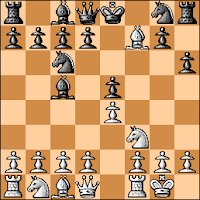 The last time I took a look at this Blackburne Shilling Jerome Gambit line (see "Pathbreaking") I pulled together some information that would be helpful for both Black and White, if they chose to wander further down the path. As the following game shows, it is important to either pay attention to the road signs or have a good GPS available
The last time I took a look at this Blackburne Shilling Jerome Gambit line (see "Pathbreaking") I pulled together some information that would be helpful for both Black and White, if they chose to wander further down the path. As the following game shows, it is important to either pay attention to the road signs or have a good GPS availableHJBUCK - fastglass
blitz, FICS, 2011
1.e4 e5 2.Bc4 Nc6 3.Nf3 Nd4
The Blackburne Shilling Gambit.
4.Bxf7+
The Blackburne Shilling Jerome Gambit.
4...Kxf7 5.Nxe5+ Ke6 6.f4
6...Bd6
7.Qg4+
This is why: "Next time White can come armed with 7.Qg4+..."
7...Ke7 8.Qg5+
Ooops.
The path was 8.Qxg7+ Ke8 9.Qf7 checkmate.
8...Nf6
Also driving into the rough.
With 8...Ke8 Black could have defended and shown that his threats were an equal to White's (which means, being a piece up, Black would be better): 9.Qxd8+ Kxd8 10.Nf7+ Ke7 11.Nxh8 Nxc2+ 12.Kd1 Nxa1.
HJBUCK didn't need a second invitation.
9.Qxg7+ Ke8 10.Qf7 checkmate
This line should join the one in "Instant Victory" in the bag of tricks that anyone who plays the Blackburne Shilling Jerome Gambit.

















































